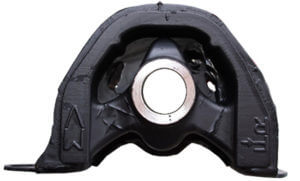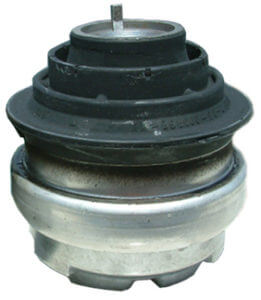Active motor mount
What is an active motor mount?
Late model cars and SUV are being equipped with at least one active motor mount to dampen engine vibration. A motor mount connects the engine to a sub-frame and allows it to move slightly. As you press on the gas pedal and then engine generates more torque, the moves in an equal and opposite reaction. So the motor mount must allow some movement. The motor mount also absorbs some vibration, preventing that vibration from transferring to the frame and passengers.
Traditional motor mounts
Traditional motor mounts are made with two metal mounting plates

Solid rubber motor mount
molded between a stiff rubber components. Those worked well with traditional V-8 engines. But as car makers started installing smaller 4-cyliner and 6-cylinder engines, the mounts couldn’t handle the vibration properly. So, engine designers had to install balance shafts in the engines to counteract the opposite movements and relieve some of the stress from the motor mounts.
Motor mounts shift to fluid filled
In addition to adding balance shafts, car makers also started using fluid filled motor mounts. The fluid filled mounts, called “hydromounts” are filled with glycol that absorbs

Fluid filled motor mount
vibration while still preventing excessive engine movement. The hydromounts are considered passive mounts in that their movement is limited by the stiffness of the rubber used, the amount of fluid added and the design of the fluid chamber. Once made, the stiffness is set.
Unfortunately, hydromounts can leak and lose their ability to dampen engine movement and vibrations. Then they must be replaced. If the car owner chooses to replace a hydromount with a less expensive traditional mount, the increase in noise, vibration and harshness will be felt and the owner will be very unhappy.
The market switches to active motor mounts
An active motor mount is similar to a hydromount in that it has a chamber that can be filled with either air or fluid. But the amount of dampening can be changed in an active mount. It can be set to absorb more vibration and movement at idle, but stiffen at higher speeds. Car makers Honda, Hyundai, Jaguar, Lexus Toyota and others switched to active motor mounts starting in 2005.
One way to vary the stiffness of an active motor mount is to use a vacuum actuator. By sucking air out of the chamber, the active motor mount becomes more like a traditional motor mount, relying more on the stiffness of the rubber than the air chamber. The PCM knows when the engine is at idle, a period when it produces the most vibration and activates a duty cycled vacuum switching valve (VSV) to apply intake manifold vacuum to the air chamber so it absorbs more vibration. At higher engine speeds, the VSV allows more air into the active motor mount, increasing its stiffness.
Active motor mount with vibration cancelling technology
Vibration cancelling is another way to reduce engine vibration. Similar to noise cancellation in headphones, an active motor mount that uses vibration cancelling technology will introduce a “countering” shock wave into the motor mount to cancel out the original vibration. The active control engine mount ECU actually generates a counter-shake through an actuator inside the active motor mount.

Magneto rheological motor mount
Magneto rheological motor mount use a different technology to vary the stiffness of the motor mount. Developed by Delphi, magneto rheological (MR) motor mounts contain a fluid filled with small particles of iron. An electric current or magnetic field is then applied to the fluid, causing the iron particles line up which increases the viscosity of the fluid. By rapidly varying the electrical current the MR motor mount can rapidly vary its stiffness.
©, 2018 Rick Muscoplat
Posted on by Rick Muscoplat
